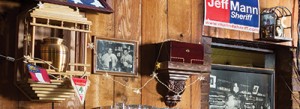I agree with the sentiment that Lawasky and Mather assert, that objects do indeed live a life beyond their own, and their afterlife is tied up in the ongoing human narrative.
According to the New York Times article about “extinct” objects of the aughts, I have the pleasure of keeping company with several dodos– the deposit slip, the foldable roadmap, the incandescent bulb, the fax machine, the cassette tape, and “smoking in bars.”
Until recently, the bar I where I work allowed smoking; I send faxes there from time to time, and I fill out a deposit slip after every shift I manage. Atlanta Magazine has plenty to say about Manuel’s Tavern.
At our bar, these inanimate objects often take on a life of their own; people ask me to tell them the stories behind all kinds weird stuff hanging on the walls and even stuck to the ceiling. Most of these items have little to no monetary value, but the history within them is beyond the dollar and subject to be lost, as the people within the stories slowly die-off and the people who know the stories slowly forget details, bit by bit. There’s a lot of oral history floating around about people, about stories, about playing cards that hold dollars up onto the ceiling, and urns filled with the ashes of people you’ve never met.
We banned smoking back in January, but the walls and ceiling are still stained with nicotine.
There’s a weird sculpture that hangs above one of the booths that many of my friends mistook for an authentic Calder, but as it turns out, my research indicated, by means of gathering informal oral histories, that an art teacher from a local institution made that sculpture while he was in prison for some serious charges. The sculpture was rumored to have been a gift to an employee of the Tavern.
I bring this up to illustrate that discovering hard facts about the history of objects, and getting down to the business of documenting their “life” and “death” can be down right confusing and difficult, as so much depends upon the availability of source information.
I think we’re left with more questions than answers.
Also, much depends on the rhetorical situation of the object in question– to what or for what end was the object brought into the situation being studied, and what significance does the object hold in the context of its current “incarnation,” and for whom does this object have value? For whom does it have meaning? For how long of a timeline does an object remain relevant? How can all of these categorical situations be subject to change due to cultural or technological evolution?
Works Cited
Burns, Rebecca. “The Museum of Manuel’s”. Atlanta Magazine. 05 August 2014. Web. 21 September 2014.
Photographs by Patrick Healy, Atlanta Magazine
McClanahan, Thayer. “Rust in Peace”. New York Times. 06 December 2009. Web. 21 September 2014.



This is an interesting way to approach the prompt. It’s an interesting thought that most knick-knacks actually have some history to them, adding a lot more depth than one would originally think.
And that you used the bar as a large object to be examined was nifty. Digging into the recent history of the place was interesting.
Good post!